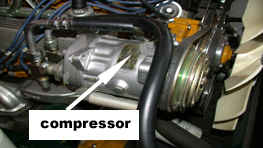System Operation: The compressor draws refrigerant gas in on its inlet side and pumps the refrigerant out on the exhaust side to the condenser. As the refrigerant gas passes through the condenser, it releases its heat to the surrounding air using the heat exchanger characteristics of the condenser. A large drop in temperature occurs within the refrigerant gas and it then condenses into a liquid by the time the refrigerant leaves the condenser, on its way towards the evaporator. The liquid refrigerant next passes through the orifice tube or expansion valve which regulates the flow of liquid refrigerant into the evaporator. The evaporator absorbs the heat from the car's interior and transfers it to the liquid refrigerant using the opposite heat exchange process that previously occurred in the condenser. The large amount of heat transfer into the refrigerant raises its temperature, resulting in the refrigerant changing from liquid back into a gas. The heat-laden refrigerant gas exits the evaporator and passes into the receiver-drier or accumulator which dries the refrigerant with its internal desiccant and also allows any liquid refrigerant to settle to prevent it from being drawn into the compressor. At this point, the cycle repeats itself, with the compressor once more drawing refrigerant gas in on its intake side.

Compressor: The compressor pumps refrigerant through the various parts of the A/C system, thereby allowing heat collected from the car's interior to moved and transferred to the air outside. The engine drives the compressor with a belt and the compressor is activated by an electro-magnetic clutch that engages and disengages the drive pulley on the front of the compressor. Based on operating conditions and driver input, an electrical signal commands the compressor to turn on when interior cooling is required. You'll find the compressor mounted directly to the engine or to an accessory bracket. A/C compressors pump only refrigerant gas, since liquids are non-compressible and would therefore cause damage to the compressor.
Condenser: The condenser works a lot like a radiator in that it releases heat, collected by the refrigerant from inside the car, into the outside air. The loss of heat results in a large temperature drop in the refrigerant, causing it to change from a gas to a liquid (condensation). The condenser earns its name for this function. For proper heat exchange, the car needs to be moving or a cooling fan (electrical or mechanical) must be operating for sufficient airflow over the condenser's fins. The condenser is located towards the front of the car, mounted in front of the radiator.
Evaporator: The evaporator absorbs heat from the interior of the car and transfers the heat to the refrigerant moving inside. As the refrigerant absorbs the heat, it changes from a liquid to a gas. The resulting chilling effect also promotes condensation of interior moisture on the evaporator’s fins, helping to greatly reduce the humidity of the air. Although the evaporator can absorb some heat on its own, its efficiency is greatly increased by the airflow provided by the A/C system’s blower motor and fan. The evaporator is located inside the heating and A/C system’s plenum. Water that collects and drips off the evaporator drains to the outside of the car through an evaporator drain tube.
Receiver-Drier/Accumulator: Your car will be equipped with either a receiver-drier or accumulator, depending on the type of air conditioning system in your car. Both perform dual roles, the first acting as a system drier and the second serving as a collection reservoir for liquid refrigerant. Both units contain a moisture-absorbing material known as desiccant, which draws moisture from the A/C system to prevent damage to it. R-12 systems use a different type of desiccant than R-134a. Sometimes, it may be necessary to replace the accumulator or receiver-drier during the retrofit procedure. This is especially true if your car has more than 70,000 miles, or is older than five years, and the system needs to be opened up for major repairs. In such instances, make sure to use an accumulator or receiver-drier with R-134a-compatible desiccant. This should be performed by a professional technician only.

